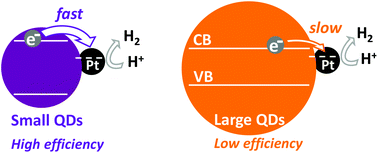Our official English website, www.x-mol.net, welcomes your
feedback! (Note: you will need to create a separate account there.)
Size-controlled electron transfer rates determine hydrogen generation efficiency in colloidal Pt-decorated CdS quantum dots†
Nanoscale ( IF 5.8 ) Pub Date : 2018-07-30 00:00:00 , DOI: 10.1039/c8nr04344b Wei Li 1, 2, 3, 4 , Frank Jäckel 1, 2, 3, 4
Nanoscale ( IF 5.8 ) Pub Date : 2018-07-30 00:00:00 , DOI: 10.1039/c8nr04344b Wei Li 1, 2, 3, 4 , Frank Jäckel 1, 2, 3, 4
Affiliation

|
Semiconducting quantum dots (QDs) have been considered as promising building blocks of solar energy harvesting systems because of size-dependent electronic structures, e.g. QD–metal heterostructures for solar-driven H2 production. In order to design improved systems, it is crucial to understand size-dependent QD–metal interfacial electron transfer dynamics, picosecond processes in particular. Here, we report that the transfer rates of photogenerated electrons in Pt-decorated CdS QDs can be varied over more than two orders of magnitude by controlling the QD size. In small QDs (2.8 nm diameter), conduction band electrons transfer to Pt sites in an average timescale of ∼30 ps, giving a transfer rate of 2.9 × 1010 s−1 while in significantly larger particles (4.8 nm diameter) the transfer rates decrease to 1.4 × 108 s−1. We attribute this to the tuning of the electron transfer driving force via the quantum confinement-controlled energetic off-set between the involved electronic states of the QDs and the co-catalyst. The same size-dependent trend is observed in the presence of an electron acceptor in solution. With methyl viologen present, electrons leave the QDs within 1 ps for 2.8 nm QDs while for 4.6 nm QDs this process takes nearly 40 ps. The transfer rates are directly correlated with H2 generation efficiencies: faster electron transfer leads to higher H2 generation efficiencies. 2.8 nm QDs display a H2 generation quantum efficiency of 17.3%, much higher than the 11.4% for their 4.6 nm diameter counterpart. We explain these differences by the fact that slower electron transfer cannot compete as efficiently as faster electron transfer with recombination and other losses.
中文翻译:

尺寸控制的电子传输速率决定了胶体Pt装饰的CdS量子点中的氢产生效率†
由于尺寸依赖的电子结构,例如太阳能驱动的H 2生产的QD-金属异质结构,半导体量子点(QD)被认为是太阳能收集系统的有前途的组成部分。为了设计改进的系统,至关重要的是要了解与尺寸有关的QD-金属界面电子转移动力学,尤其是皮秒过程。在这里,我们报道通过控制QD尺寸,Pt装饰的CdS QD中光生电子的传输速率可以在两个以上的数量级内变化。在较小的量子点(直径为2.8 nm)中,导带电子以平均约30 ps的时间尺度转移到Pt位置,转移速率为2.9×10 10 s -1而在较大的颗粒(直径4.8 nm)中,传输速率降低至1.4×10 8 s -1。我们将其归因于通过量子约束控制的量子点和助催化剂之间的量子限制控制的能量偏移来调节电子转移驱动力。在溶液中存在电子受体时,观察到相同的尺寸依赖性趋势。在存在甲基紫精的情况下,对于2.8 nm QD,电子在1 ps内离开QD,而对于4.6 nm QD,此过程将花费近40 ps。传输速率与H 2生成效率直接相关:更快的电子传输导致更高的H 2生成效率。2.8 nm QD显示H 2产生的量子效率为17.3%,远高于直径4.6 nm的11.4%。我们通过以下事实来解释这些差异:较慢的电子传输不能像具有重组和其他损失的较快电子传输一样有效地竞争。
更新日期:2018-07-30
中文翻译:

尺寸控制的电子传输速率决定了胶体Pt装饰的CdS量子点中的氢产生效率†
由于尺寸依赖的电子结构,例如太阳能驱动的H 2生产的QD-金属异质结构,半导体量子点(QD)被认为是太阳能收集系统的有前途的组成部分。为了设计改进的系统,至关重要的是要了解与尺寸有关的QD-金属界面电子转移动力学,尤其是皮秒过程。在这里,我们报道通过控制QD尺寸,Pt装饰的CdS QD中光生电子的传输速率可以在两个以上的数量级内变化。在较小的量子点(直径为2.8 nm)中,导带电子以平均约30 ps的时间尺度转移到Pt位置,转移速率为2.9×10 10 s -1而在较大的颗粒(直径4.8 nm)中,传输速率降低至1.4×10 8 s -1。我们将其归因于通过量子约束控制的量子点和助催化剂之间的量子限制控制的能量偏移来调节电子转移驱动力。在溶液中存在电子受体时,观察到相同的尺寸依赖性趋势。在存在甲基紫精的情况下,对于2.8 nm QD,电子在1 ps内离开QD,而对于4.6 nm QD,此过程将花费近40 ps。传输速率与H 2生成效率直接相关:更快的电子传输导致更高的H 2生成效率。2.8 nm QD显示H 2产生的量子效率为17.3%,远高于直径4.6 nm的11.4%。我们通过以下事实来解释这些差异:较慢的电子传输不能像具有重组和其他损失的较快电子传输一样有效地竞争。











































 京公网安备 11010802027423号
京公网安备 11010802027423号